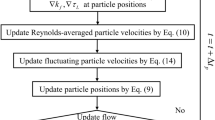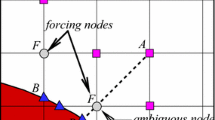Abstract
An improved implementation of Distributed Lagrange multiplier/fictitious domain method was presented and used to simulate the interactions between two circular particles sedimenting in a two-dimensional channel. The simulation results were verified by comparison with experiments. The results show that the interactions between two particles with different sizes can be described as drafting, kissing, tumbling and separating. Only for small diameter ratio, the two particles will interact undergoing repeated DKT (Drafting, Kissing and Tumbling) process. Otherwise, the two particles will separate after their tumbling. The results also show that, during the interaction process, the motion of the small particle is strongly affected while the large particle, is affected slightly.
Similar content being viewed by others
References
Davis R H, Acrivos A. Sedimentation of noncolloidal particles at low Reynolds numbers[J].Ann Rev Fluid Mech, 1985,17:91–118.
Fortes A, Joseph D D, Lundgren T S. Nonlinear mechancis of fluidization of beds of spherical particles[J].J Fluid Mech, 1987,177:467–483.
Ritz J B, Caltagirone J P. A numerical continuous model for the hydrodynamics of fluid particle systems[J].Int J Numer Meth Fluids, 1999,30(8):1067–1090.
Feng J, Hu H H, Joseph D D. Direct simulation of initial value problems for the motion of solid bodies in a Newtonian fluid. 1. Sedimentation[J].J Fluid Mech, 1994,261:95–134.
Smereka P. On the motion of bubbles in periodic box[J].J Fluid Mech, 1993,254:79–112.
Sangani A S, Didwania A K. Numerical simulation of flows of bubbly liquids at large Reynolds number[J].J Fluid Mech, 1993,250:307–337.
Brady J F, Bossis G. Stokesian dynamics[J].Ann Rev Fluid Mech, 1988,20:11–157.
Hu H H, Joseph D D, Crochet M J. Direct simulation of fluid particle motions[J].Theor Comp Fluid Dyn, 1992,3(5):285–306.
Glowinski R, Pan T W, Hesla T I,et al. A distributed Lagrange multiplier/fictitious domain method for particulate flows[J].Int J Multiphase Flow, 1999,25(5):755–794.
Shao X M, Lin J Z, Yu Z S. Sedimentation of a single particle between two parallel walls[J].J Zhejiang University Sci, 2004,5(1):111–116.
Shao Xueming. Direct simulation of particulate flows[J].J Hydrodynamics, 2003,15(3):89–95.
Author information
Authors and Affiliations
Corresponding author
Additional information
Communicated by LIN Jian-zhong
Project supported by the National Natural Science Foundation of China (No. 10472104) and the Natural Science Foundation of Zhejiang Province Government (No. 101047)
Rights and permissions
About this article
Cite this article
Xue-ming, S., Yang, L. & Zhao-sheng, Y. Interactions between two sedimenting particles with different sizes. Appl Math Mech 26, 407–414 (2005). https://doi.org/10.1007/BF02440092
Received:
Revised:
Issue Date:
DOI: https://doi.org/10.1007/BF02440092




